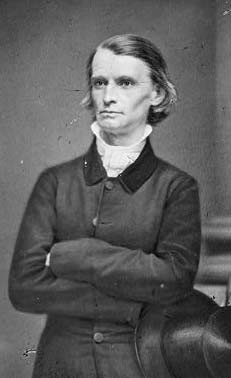Arming Virginia: Henry Wise’s Attempts to Prevent Another John Brown’s Raid

The word of John Brown’s Raid on Harpers Ferry struck the Governor’s Mansion in Richmond, Virginia like a thunderbolt. Immediately, the lanky Henry Wise sprang into action. He called on the state’s militia to help suppress the uprising before journeying to Harpers Ferry himself to subdue the raiders.

A slowed train delayed Wise’s arrival in Harpers Ferry until after the climactic moment of Brown’s capture. Several hours after that signal event, the governor and his train chugged into the excited town. Wise instantly sought out the raid’s ringleader. The authorities on hand led the governor to the United States Armory’s paymaster’s office, where the wounded Brown lay on the floor. As Brown and Wise exchanged glances, the two tough men, who could hardly have been more different politically, soon found common ground.
Brown began the dialogue, respectfully telling Wise, “Well sir, we have our opinions of each other” before launching into his plans. The conversation created respect between the two men. “He is a fanatic, vain and garrulous,” Wise later said, “but firm, and truthful, and intelligent.”
Despite the suddenly found respect Wise held for Brown, he wanted to ensure that no more John Browns caused any future disruptions in his state. Governor Wise felt certain that if any future fanatics tried to emulate Brown, the threat would come from outside Virginia’s borders.
To that end, Wise informed the states bordering Virginia’s northern boundary that he would preserve “the peace of our coterminous borders,” even if it meant pursuing the “invaders of our jurisdiction into yours.” However, doing so was the last resort. Wise took other steps to dissuade any prospective invaders from visiting Virginia in the first place.

“Virginia is arming to the teeth,” penned former President John Tyler from central Virginia in the wake of Brown’s Raid. This effort to arm Virginia’s militia and formalize its system was not a mere attempt to thrust arms into the hands of Virginians statewide. No, Wise turned to the border first to create a wall of fire on the periphery of the state that protected the rest of it.
The December 10, 1859 edition of The Shepherdstown Register reported that the local cavalry militia company recently received a supply of pistols and Sharps’ rifles. Situated on the state’s border with Maryland, shipments of arms like this were crucial to Wise’s defense plan. “It is the intention of Gov. Wise to arm the troops along the line of the Potomac with the best of arms that can be procured,” the paper noted.
On his way out of office at the end of 1859, Wise’s parting words to his fellow politicians in the Virginia Assembly were: “We must rely on ourselves. I say then–To your tents! Organize and arm!”
Of course, another John Brown did not materialize on Virginia’s borders. Whether or not Wise’s calculated arming of the state’s boundary counties preempted any future attempts is impossible to say. But he made sure another raid like that of October 1859 did not occur on his watch. Doing so paid large dividends for Virginia’s military preparedness come April 1861.
Three points: John Brown had considered “reinforcements” from the north, prior to launching his assault at Harpers Ferry, but in the end, did not rely on anything except his own armed band and the “recruits to be gained from Southern plantations” over the course of an insurgency conducted from the mountains. [Those officials in Virginia would have no way of knowing if “help was coming for Brown,” and so had to exercise precautions.]
Second point: Plans were developed to break out Hazlett and Stevens prior to their executions in March 1860 (according to Oswald Villard.) Vigilance on the part of Virginia militia would have contributed to the ultimate abandonment of that operation.
Third: The last year of the 1850s decade, continuing into early 1861, saw an explosion of interest, North and South, in the Zouave movement: Elmer Ellsworth toured his American Zouaves across the Northern states, including in Washington, D.C., with many copycat units initiated from New Orleans to New York. And the Wide-Awake movement, which put to use military drill and precision in support of Republican candidates, flamed brightly during 1860 (and many members of the Wide-Awakes transitioned to volunteer infantry regiments in the North with the eruption of War at Fort Sumter.) The mobilization of men for armed conflict could be argued as coincidental to John Brown’s Raid; but that pre-Secession mobilization took place, nonetheless.
I’m sure the memories of Nat Turner’s rebellion came flooding back to Virginians in the wake of John Brown’s raid—and the jubilation of some (not all) Northern abolitionists over it. I’ll stipulate that I’ve not read deeply into the history of Nat Turner’s raid. But, from what I have learned, he had been taught to write and converted to Christianity before he launched his raid. In his raid, he not only killed slaveholders, but their families, too.
Imagine the fears that would engender among white Virginians. A slave who knew how to read and write, and knew Christian teachings, had slaughtered helpless women and children. Now, a fanatic had come from outside the state and tried to stir up another slave rebellion. And some (again, not certainly not all) abolitionists, who certainly remembered the butchery of Turner’s rebellion, were crowing in support of John Brown and calling for more rebels like him.
Now imagine you are a poor white subsistence farmer in Virginia, with a family. You may not love slavery, but you certainly love your family. You’d probably want Governor Wise to arm and strengthen the state militia, too.